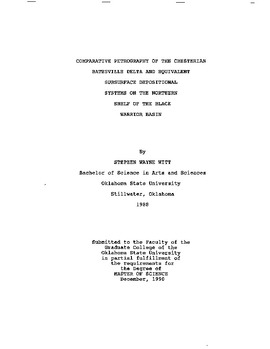| dc.description.abstract | The Black Warrior Basin is a triangular Late Paleozoic foreland basin whose primary sedimentary fill consists of Upper Mississippian (Chester Group) and Lower Pennsylvanian (Pottsville Group) terrigenous clastic rocks. Among the Chesterian deltaic sandstones, the Carter Sandstone, deposited on the structurally stable Northern shelf, contains significant quantities of natural gas and liquid hydrocarbons. The Carter Sandstone is the most productive hydrocarbon reservoir of the Black Warrior Basin, but is still poorly understood in regard to the diagenetic and depositional facies characteristics. The Chester-age Batesville Delta complex was deposited in Northeastern Arkansas. This delta never reached the Arkoma Basin. Longshore currents carried detritus the westward creating a strandplain type depositional environment. It is difficult to determine the exact nature of the depositional system, because Mississippian sediments are absent east of Batesville, Arkansas in what is now called the Mississippian Embayment. The principle subsurface source of data for this study were more than 900 electric logs, from which subsurface maps 1 in Mississippi were constructed. Production trends, as determined from published data, were related to isolith and structural contour maps generated by this study. Five cores from the Mississippi study area and three outcrop measured sections from the Arkansas study area were analyzed in order ' to determine th~ diagenetic controls of porosity and permeability and to determine whether the detrital constituents indicate a cratonic source. The Carter Sandstone was deposited in an elongate, ,� (high-constructional) cratonic delta complex that prograded from NNW to SE. Deposition of this fluvial-deltaic facies marked the end of a series of minor transgressive-regressive patterns of sedimentation in the basin. The development of porosity and permeability within the Carter Sandstone was controlled by the absence/presence of authigenic quartz overgrowths and calcite cement, along with the absence/presence of pore-filling authigenic illite, kaolinite, dolomite, and siderite. Optimum conditions exist when secondary porosity, created by dissolution of detrital matrix and metastables, are free of the pore-filling and pore-lining authigenic kaolinite, illite, dolomite, and siderite, thus allowing connection of the enlarged pores created by dissolution. Carter production trends tend to correlate well with the trends indicated on sandstone-isolith maps. Structural trapping, particularly the antithetic (down to the north) faults, and anticlinal features, played a major role in the entrapment of hydrocarbons in the basin. Stratigraphic trapping is minor within the study area but is one of the main trapping mechanisms to the east in Fayette and Lamar Counties, Alabama. | |
